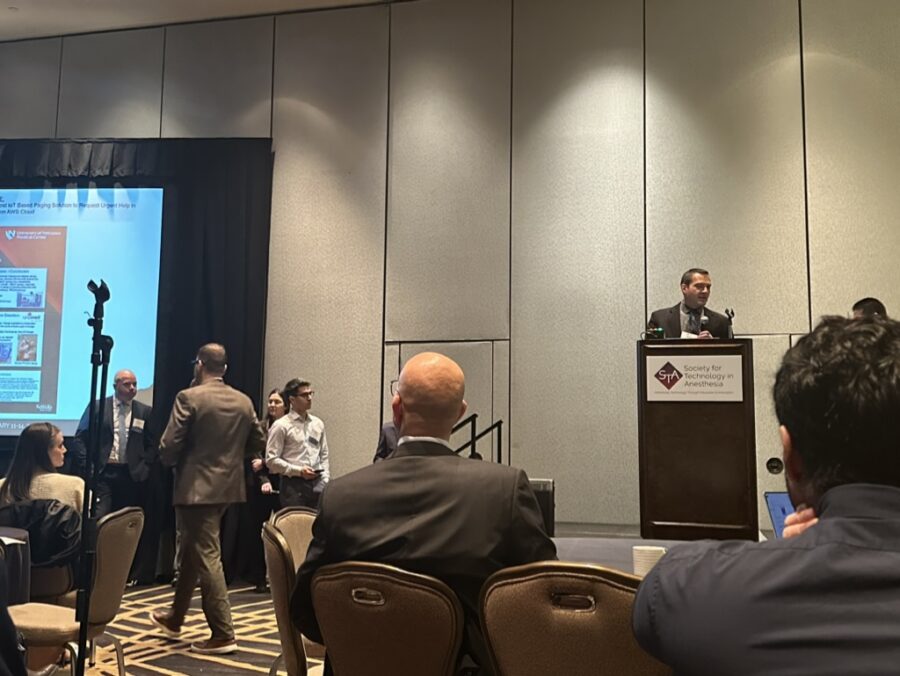Driven by a passion for improving patient care, Nathan Goergen, MD, PhD, a
resident in the UNMC department of anesthesiology, bridges the gap between
engineering and medicine.
Dr. Goergen completed his undergraduate degree in electrical engineering at
Rose–Hulman Institute of Technology in Indiana. Straight out of college in
2004, he developed communication systems for military satellites, working for
Rockwell Collins in Cedar Rapids, Iowa.
In his spare time, Dr. Goergen found himself drawn to the world of computer
science, prompting him to pursue a master’s degree online through DePaul
University. This interest eventually evolved, leading him to make a pivotal
decision to pursue a PhD in electrical engineering, fueled by a Department of
Defense scholarship.
Simultaneously, his wife Katie Goergen, MD, now an associate professor in
the department of anesthesiology, was working through her residency and
fellowship in Baltimore.
Dr. Goergen found himself becoming interested in a career in medicine. He
fulfilled the prerequisites for medical school, undertaking seven undergraduate
courses in biology, chemistry and genetics over a year and a half, a task he
described as daunting.
While working on software development projects, Dr. Goergen completed
medical school and began his residency in anesthesiology, where he realized he
could leverage his engineering skills to bridge gaps in health care.
One of his projects emerged from a critical need within the hyperbaric
oxygen unit at UNMC. Facing a shortage of specialized IV tubing, Erin
Etoll-Jones, MD, approached Dr. Goergen with the possibility of using arterial
tubing as a potential solution. Dr. Goergen worked on the design of a
3D-printed adapter, solving the problem affordably and efficiently.
“I thought — there’s got to be a way we can fix this,” Dr. Goergen said.
“We have generic tubing to do arterial lines, it’s a bit stiffer. I developed
an adapter that can be 3D printed and fits around the arterial line tubing and
the hyperbaric oxygen tubes. It costs about 11 cents to make, and we can print
as many as many of them as we want.”
Another significant project, the “Low-Cost Open-Source Syringe for
Anesthesia Delivery in Developing and Resource-Poor Countries,” addressed
a need identified during global health trips to Zambia and Rwanda. Dr. Goergen
devised an open-source syringe, utilizing readily available components to
facilitate accurate medication delivery in resource-limited settings.
Dr. Goergen said engineers love taking human error out of the equation. “I
guess it’s the engineer in me – I think a little differently than the people
that have been strictly on a medicine track their whole career.”
“Anytime you can eliminate a human from the process, not only is it
usually a little bit more reliable and safer, but that frees us up as humans to
think about bigger, more important problems,” he said. “Let the machine and the
software and the computer do the mundane things. I’m going to start thinking
about the next big problem and solve it.”
Dr. Goergen describes the types of pumps used at Nebraska Medicine to
deliver medications in the operating room or the ICU. One is an IV tubing pump
that squeezes the tubing to deliver the medication at the necessary rate, and
the other is a syringe.
“It’s exactly how it sounds — a mechanical device that pushes the syringe
plunger at a programmed rate to deliver the medication,” Dr. Goergen said. “One
of the challenges my colleagues faced in Zambia was the different types of
ventilators; none of them interoperated and half were malfunctioning. And no
pumps, no pumps at all.”
Dr. Goergen said it was during his OB rotation that he started trying to
find a solution to reliably deliver medication to women in Zambia and Rwanda
without the same technology. He took his vision to his former mentor, Mario
Simoni, PhD, chair of the electrical and computer engineering department at
Rose Hulman and presented his idea as a possible capstone project for
engineering students.
“I’ve been mentoring projects through the ECE department, and I approached
Dr. Simoni with the idea of making a very low-cost syringe pump,” Dr. Goergen
said. “Let’s make it open source, meaning anybody in the world can download it,
build it 3D printed, improve on it, tweak it, and I want to do it for under $100.”
With the support of Dr. Simoni and Karsten Bartels, MD, PhD, vice chair of
research in the UNMC department of anesthesiology, Dr. Goergen is working with
senior engineers, designing a syringe pump that will someday have a major
impact on health care in developing countries.
“I’ve been extremely impressed with the design that the students have come
up with,” he said. “We have the best equipment and technology, and I can’t
think of a good reason not to level the playing field so patients in places
like Zambia have access to the same level of care we do.”
This work has earned Dr. Goergen the Lieberman Research Award and a Best of
Meeting Award at the American Society of Anesthesiologists annual meeting in
Oct. 2024.
